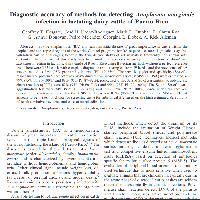Resumen
-
Bovine anaplasmosis (BA) is a hemoparasitic disease of great importance in cattle within the
tropical and subtropical regions of the world. Control programs for BA require accurate diagnostic assays but
validation can be challenging because the true disease status of all animals is frequently not known with
certainty. The objective of this study was to estimate the accuracy of assays for detection of Anaplasma
marginale infection in lactating dairy cattle of Puerto Rico using Bayesian methods without a perfect reference
test. There were 2,331 cattle with complete diagnostic results sampled from 79 herds, and the prevalence of BA
was estimated as 22% (95% probability interval [PI]: 19–25%). The sensitivity (Se) and specificity (Sp) of a
major surface protein 5 competitive enzyme-linked immunosorbent assay (MSP-5 cELISA) were estimated as
99% (95% PI: 96–100%) and 89% (95% PI: 87–92%), respectively. The Se and Sp of a quantitative polymerase
chain reaction (qPCR) were 67% (95% PI: 60–74%) and 99% (95% PI: 99–100%). The Se and Sp of a card
agglutination test were 34% (95% PI: 29–39%) and 99% (95% PI: 99–100%). Area under the receiver-
operating characteristic curve for the MSP-5 cELISA was 0.748 (95% PI: 0.71–0.79). The MSP-5 cELISA
appears to be the test of choice for screening cattle for subclinical BA based on the high estimated Se, rapidity
of results, relative low cost, and ease of standardization.
